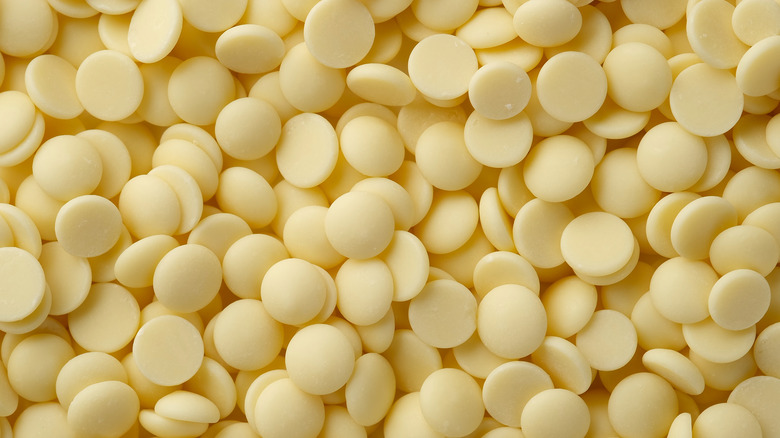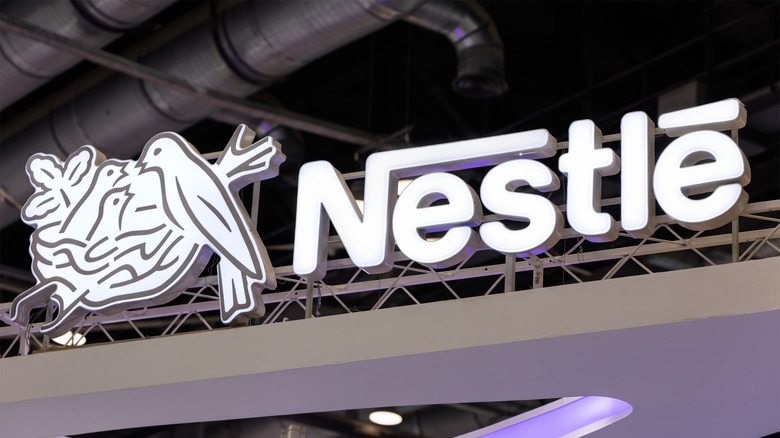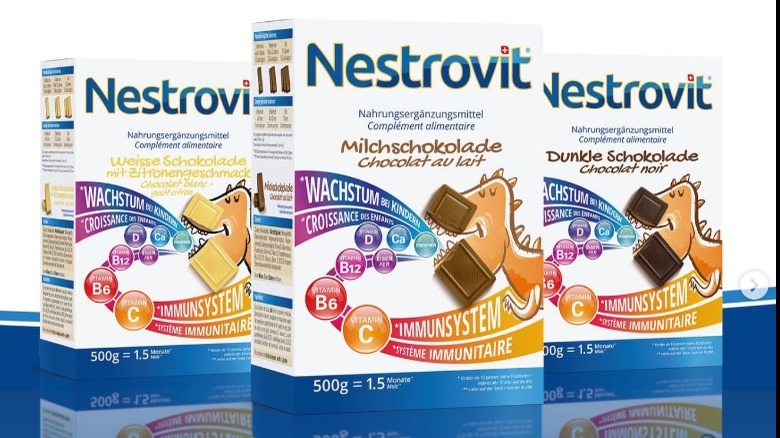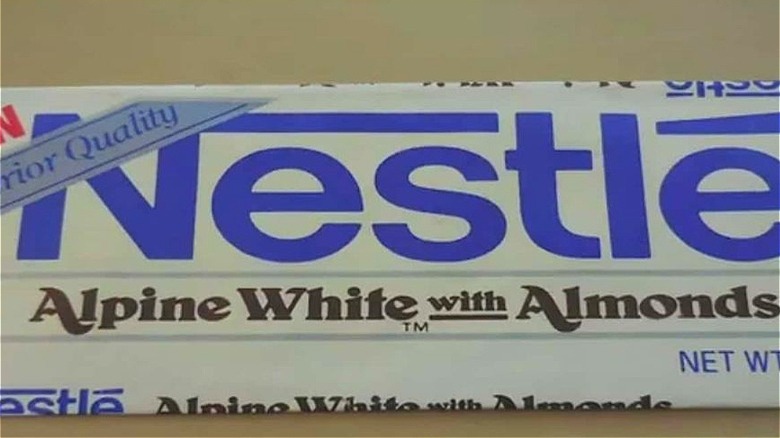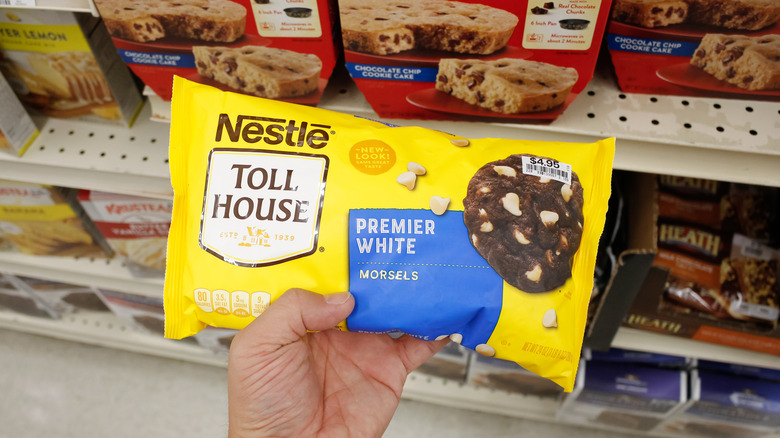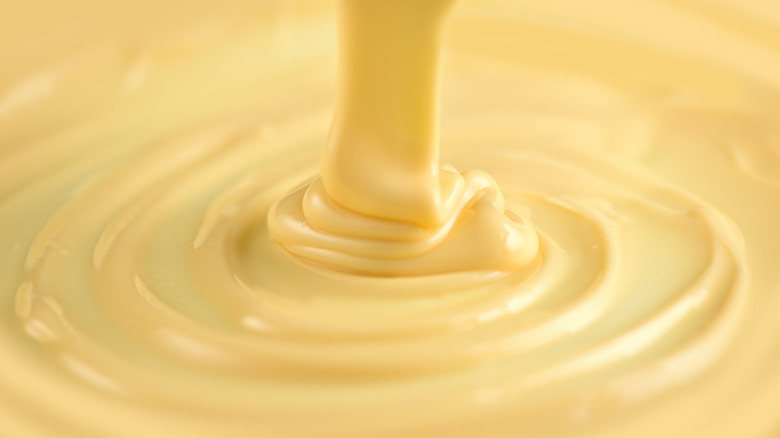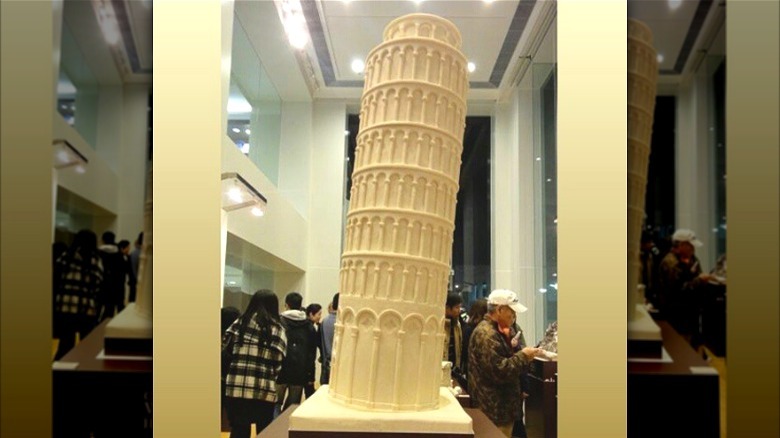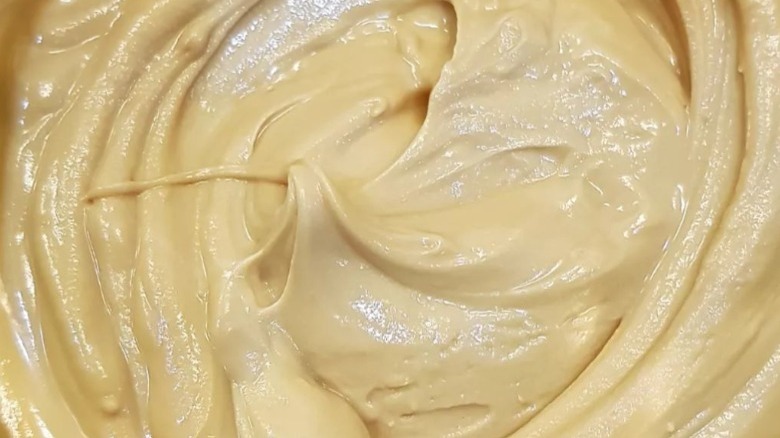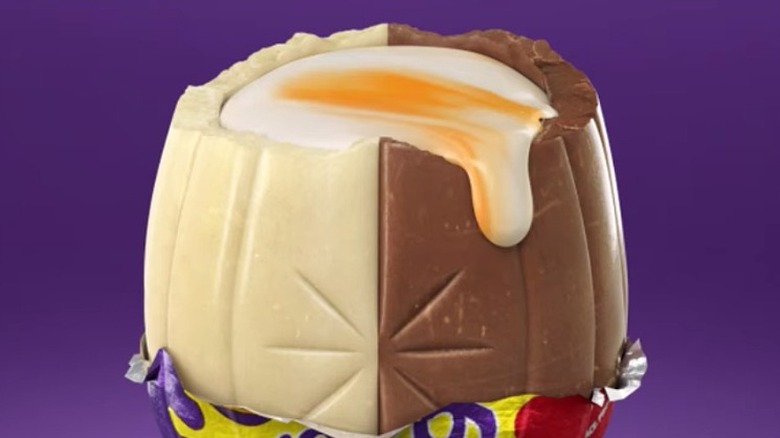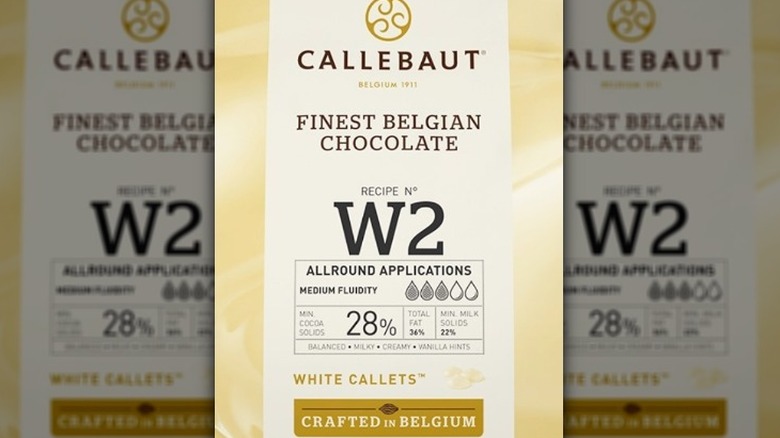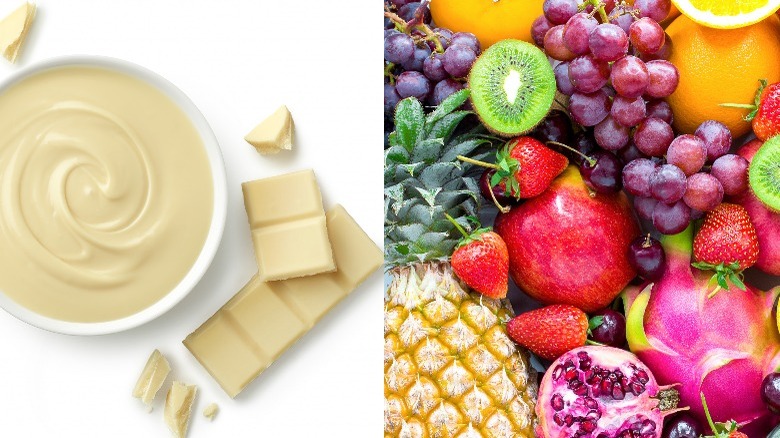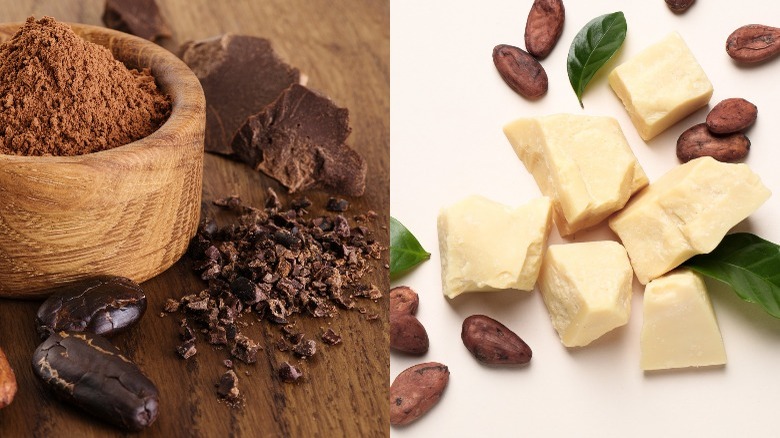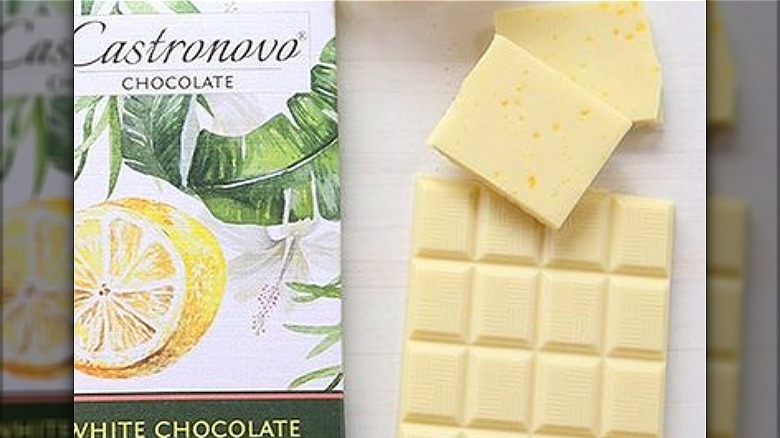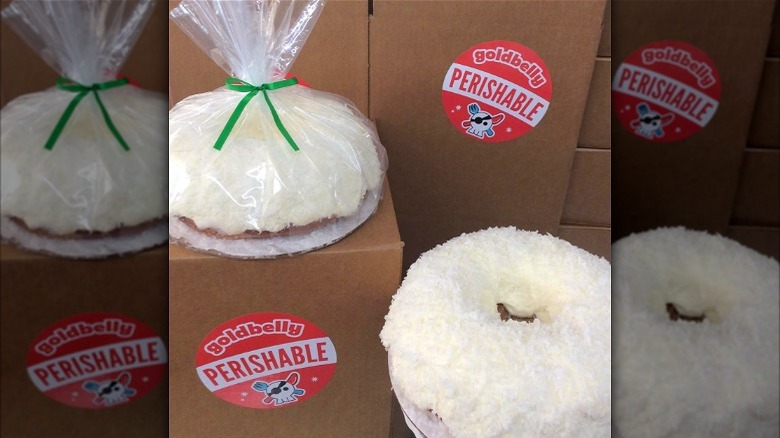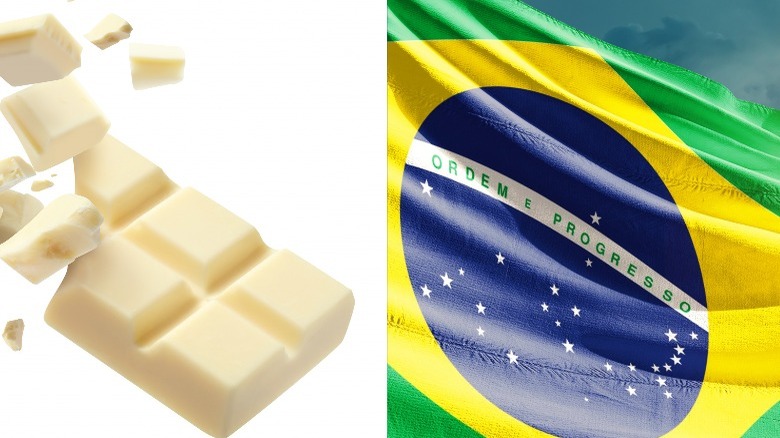The Untold Truth Of White Chocolate
We may receive a commission on purchases made from links.
A white chocolate conversation can be a polarizing one, but as with any civil discourse, there is much to learn about the confection. White chocolate is made from sugar, cocoa butter, milk fat, vanilla, and lecithin (via Bon Appétit). Although a lack of cocoa solids prevents the candy from claiming a true chocolate identity (at least by some standards), it's hard to argue against white chocolate's light and buttery taste and creamy texture. Thanks to cocoa butter, white chocolate dissolves on the tongue almost instantly into a puddle of sweet and creamy decadence.
Despite white chocolate's relatively recent history, the pastry world quickly adopted its versatile flavor and cooperative structure. Artisan chocolate companies are exploring the intricacies of fine white chocolate and its unique opportunity for innovation within a vast dessert terrain. For reasons like this, the global white chocolate market is expected to grow $1.78 billion between 2020 and 2025, a notable upward trend that supports premium and high-end white chocolate product demands (via technavio). Who knows? Maybe the closer we look at the untold truths of white chocolate, the more the world will come to understand and embrace its seductive sweet tooth plea.
Nestlé was the first to produce and market white chocolate
Nestlé is nothing short of a household name and global dairy dignitary. For those of us who grew up drinking Nesquick (both strawberry and chocolate) like it was water, it may be surprising to learn that the global food and drink empire originated in Switzerland (via Style). Not only that, but the Swiss chocolate company was the first to develop commercial white chocolate in 1936 (via The Washington Post).
As a 20th-century culinary addition, what finally propelled this sweet and creamy invention? Believe it or not, a specific underutilized ingredient reshaped the chocolate world forever. According to white chocolate historians, the chocolate alternative, rich with abundant cocoa butter, was created to use up leftover milk powder from World War I supplies (via The Washington Post). Post-war dairy consumers reverted to fresh milk tendencies, which left lingering milk powder unclaimed. Chocolate production already cultivates cocoa butter excess, so a milk powder surplus and an anti-waste attitude sparked white chocolate's thunderous entry into the grand world of chocolate. Soon, white chocolate would make its way across the Atlantic and into stores around the world.
It was originally intended to be used for a children's vitamin supplement
The Nestlé empire had unlikely beginnings and milk powder wasn't the only compelling white chocolate factor. Henri Nestlé, originally a Swiss chemist, tapped into his scientific roots and innovative spirit to use up excess ingredients for a very specific purpose — to change people's lives for the better (via Style). White chocolate's original form wasn't intended to be eaten the way we eat it today — in glossy and luxurious bar form. Nestlé had a very specific and purposeful initial function in mind.
In the 1930s, Nestlé joined forces with Roche, a pharmaceutical company, to work on a children's vitamin supplement called Nestrovit (via Style). The product required a coating to preserve the vitamins, and after recalling his previous milk chocolate endeavors a few decades earlier, Nestlé toyed with a new concept that eliminated cocoa solids altogether and instead embraced cocoa butter's solitary state with a little help from milk and sugar. Unsurprisingly, Nestlé realized that the combination of buttery cocoa fat, creamy milk, and tasty sugar was a pleasant combination for everyone. So, although children were able to reap the early innovation benefits, soon, a new chocolate product — a rendition without vitamins — would join the dessert snack repertoire. In 1936, Nestlé's Milkybar (alternatively known as Galak in certain regions) hit European markets and the rest is history (via Coeur de Xocolat).
Nestlé's Alpine White was the first mass-distributed white chocolate bar in the US
Shortly after white chocolate's European debut, Nestlé headed for the United States with a product designed for the American sweet tooth. The Alpine White bar hit shelves around 1948 across the U.S., thus becoming the first mass-distributed white chocolate in the country (via The Nibble). With a healthy dose of sugar, cocoa butter, milk, almonds, and vanilla, the white chocolate bar quickly acquired a fan following (via The Candy Wrapper Museum). A 1986 Nestlé Alpine White television advertisement still excites today, with ethereal cloud imagery, ice skating choreography, and a warm hugging embrace between two people while they cling to an Alpine white bar.
The Alpine white chocolate bar was discontinued in the 1990s, leaving behind a devastated group of fond white chocolate bar enthusiasts. Passionate fans eventually forged a Facebook group dedicated to the Nestlé bar's revival with over 6,000 members who continue to petition for a comeback.
White Chocolate is regulated by the FDA
At first glance, Nestlé's Premier White Morsels appear to be real white chocolate. But if you notice on the package, the word "chocolate" is conspicuously absent. That's because according to the U.S. Food & Drug Administration, white chocolate must contain at least 20% cocoa solids, 14% milk solids, 3.5% milkfat, and a maximum of 55% nutritive carbohydrate sweetener. And while the iconic yellow Nestlé white morsel packaging stands out on supermarket shelves, flip the bag over and the ingredients lack any cocoa butter product at all. Instead, fractionated palm kernel oil and hydrogenated palm oil blend with predictable milk solids and sugar to create a bright white baking chip. Clear FDA direction requires any deviations from this prescriptive white chocolate recipe to find an alternative name, and so, Nestlé's Premier White Morsels were born.
So, why should the average chocolate consumer care about a label? Well, during an exclusive interview with Mashed, French chocolate genius Jacques Torres helps shed light on white chocolate's broader status amongst its fellow milk and dark chocolate siblings. Torres settles the tumultuous chocolate debate regarding whether the white variety is considered real chocolate. He claims, "If cocoa butter is there, then it is officially chocolate." Torres and the FDA agree that cocoa butter is essential to white chocolate production, requiring all imitations to disclose even the subtlest omissions.
Yellow is best when it comes to quality white chocolate
While on the topic of white chocolate credentials, let's talk quality. Many white chocolate haters are quick to point out its shortcomings, but good white chocolate is often misunderstood. Most importantly, not all white chocolate is created equal, and one of the easiest ways to identify quality white chocolate can be done with the naked eye.
Chocolate expert Eagranie Yuh expands on what makes white chocolate great and worthy of critical acclaim. In a Washington Post interview, Yuh stresses the importance of white chocolate's color. She explains, "High-quality white chocolate tends to be slightly yellow because cocoa butter is naturally yellow." The whiter the chocolate, the more processed, bleached, and deodorized it is, leading to a bar that is deplete of cocoa aromas and complex buttery depth. Although pearly white chocolate may please the eye, a slight yellow tint indicates the presence of real cocoa butter richness and ensures the best white chocolate eating experience. Cocoa butter in its purest form is responsible for the smooth, soft, and melt-on-the-tongue consistency (via Food Network).
White chocolate is used to create edible architecture
A plethora of edible architecture television programs, like Food Network's "Cake Wars" and "All-Star Gingerbread Build" are generating household awe across the world, and chocolate's structural capabilities are among the most impressive. The delicate nature of brittle pieces, precise tempering requirements, and dramatic height appendages are enough to capture a viewing audience with thrilling anticipation.
Italian chocolatier Mirco Della Vecchia undertook a grand white chocolate endeavor in 2011 when he constructed seven world-famous tourist destinations with 100% white chocolate (via Daily Mail). After shifting from pastry to artisan chocolate production in 2006, Della Vecchia took home the title of Italian chocolate champion in 2007 and 2008 and later won three bronze medals at the 2008 Culinary Olympics in Erfurt, Germany (via L'Angelica Instituto Erboristico). New chocolatier fame pushed Della Vecchia to do something big with chocolate as his prized subject, and naturally, he turned to white chocolate to create visually stunning architectural masterpieces.
The Chocolate World Heritage landmark collection — made 100% from tempered, molded, and carved white chocolate — reproduced the Arc de Triomphe, the Parthenon, the Leaning Tower of Pisa, the Colosseum, the Dome of Milan, the Egyptian temples Abu Simbel, and Stonehenge (via Daily Mail). Impeccable details point to hours and hours of intricate work with details remarkably emulating the original structures. Grandiose doesn't do the white chocolate exhibit justice — the Dome of Milan was nearly 5 feet tall, 8 feet long, and weighed over 10,000 pounds.
You can roast white chocolate
Roasted white chocolate, also referred to as caramelized white chocolate or blonde chocolate, shatters all preconceived notions of chocolate's ability for modification. If you've ever made the mistake of melting chocolate without a double boiler, you're well aware of its precarious nature. The tiniest drop of water seizes chocolate's luscious and creamy nature, high heat will cause the lot to burn, and improper tempering leaves a cooled final product with "blooming" splotches. So, white chocolate may provide the easiest and most rewarding opportunity for cocoa transformation.
Generous cocoa butter and sugar amounts allow white chocolate's sugary and fatty qualities to caramelize with a little extra heat. According to Southern Living, caramelized chocolate is easily achievable in a home oven. All that's required is a low-temperature oven with occasional stirring and smoothing to transform white chocolate into a darker-hued substance revamped with notes of nutty caramel. A welcoming chocolate world is getting on board with the caramelized white chocolate trend. Chocolate companies are producing store-bought caramelized white chocolate products for at-home bakers and Starbucks introduced a holiday Toasted White Chocolate Mocha to their coffee menu in 2018 (via Eater).
The white chocolate Cadbury Cream Egg caused a UK Easter frenzy
In 2018, the United Kingdom got caught up in an Easter-holiday chocolate frenzy thanks to Cadbury's inaugural white chocolate Creme Egg. The catch? Obtaining the coveted limited edition white chocolate eggs was like looking for a pin in a haystack, a Willy Wonka experiment if you may (via Today). Around 400 White Chocolate Creme Eggs were dispersed among many milk chocolate eggs in grocery stores across the country. Both the milk chocolate and limited-edition white chocolate eggs were disguised in the same foil wrapping, posing as the other and incentivizing bulk purchases.
As if the stakes weren't high enough, Cadbury threw in a cash prize for the lucky few who found a white chocolate cream egg hidden underneath the foil. A special Cadbury hotline stood by, waiting for eager chocolate-lovers to call and claim monetary prizes worth between 100 and 2,000 pounds (via Today). Twitter archives validate white chocolate's ability to seize the attention of an entire nation, and the 2022 Cadbury creme egg hunt revival has eager competitors looking forward to Easter festivities.
Callebaut Chocolate sells an 11-pound white chocolate slab
Callebaut is one of the best names in chocolate. The company started over a decade ago in Wieze, Belgium, and after generations of fine chocolatier work, Octaaf Callebaut's original N˚ W2 white chocolate recipe lives on in massive form — as an 11-pound bar that measures over an inch thick and nearly 17 inches long (via Callebaut). With an 18 month shelf life, home bakers can chip away at the slab whenever they get a baking urge or white chocolate sweet tooth.
Callebaut's fine Belgian white chocolate uses cocoa beans harvested from the Ivory Coast, Ghana, and Ecuador to create a white chocolate blend with sweet, creamy, and light vanilla flavors. A medium fluidity allows for versatile chocolate applications, which means enrobing, molding, piping, and airbrushing are all possible with Callebaut white chocolate (via Callebaut). Other applications like custards, mousses, and ganaches allow for unique flavor pairings. Lemon, black sesame seeds, and Sichuan pepper are among Callebaut's most trusted white chocolate flavor pairings.
White chocolate reigns supreme when it comes to cocoa fruit pairings
White chocolate receives plenty of criticism. But the truth is, it plays better with fruit pairings than any other chocolate type, opening a world of pastry and dessert possibilities that no other chocolate can unlock. Per Hotel Chocolat, white chocolate's high cocoa butter percentage, delicate taste, and unctuous creaminess compliment all kinds of fruit without the dominating qualities that milk and dark chocolate possess. White chocolate's effortless creaminess and sweetness can compliment a mango tart, a raspberry mousse, or even a lemon curd pavlova — the fruit pairings are nearly endless.
For concrete evidence, let's compare white chocolate's versatility to milk and dark. From a list of 30 fruits, white chocolate pairs well with 26 of them, while milk chocolate and dark chocolate peacefully coexist with as little as 14 fruit types (via PreGel America). Expert recommendations in "The Flavor Bible" share further fruity evidence. Pairing suggestions venture to cherries, papaya, persimmon, and even pomegranate.
Cocoa solid remnants from white chocolate production do not go to waste
Cocoa butter is an essential white chocolate component, but what happens to the extracted cocoa solids that don't make the final blonde cut? Well, the cocoa solids turn into another pantry baking staple — cocoa powder. Believe it or not, the chocolate-making process separates the solids from the cocoa butter anyway, and only when the two are recombined with additional milk and sugar do you have milk or dark chocolate (via Live Science). Until then, the chocolate solids are turned into cocoa powder and await further instruction from chocolate authorities.
Cocoa butter extraction is a multifaceted and multi-step process. Raw cocoa beans are fermented, dried, and roasted before the cocoa nibs are extracted from the bean's shell (via Cacao). From there, the nibs are ground into cocoa liquor, and the fat (cocoa butter) naturally separates from the cocoa solids. Any unused cocoa butter stands by for white chocolate production (via The Washington Post). There is a definite method to the cocoa butter madness. Recognizing cocoa butter's smooth and buttery mouthfeel, chocolatiers can play with percentages — as long as it meets the minimum 20% cocoa butter threshold — to create unique white chocolate recipes.
White chocolate fans are on a mission to push back against the haters
White chocolate receives some harsh criticism. Some claim it's not chocolate at all. Others show disdain for the taste alone. But persuasive counterarguments favoring white chocolate's strengths are getting louder and pushing back against the hate. Denise Castronovo, the founder of Castronovo Chocolate, believes white chocolate is misunderstood (via The Washington Post). When she started Castronovo Chocolate, she wanted to share "what real white chocolate actually is" and fill a market void of quality bars. She claims that white chocolate is the perfect mild and sweet conduit for a slew of creative flavor additions.
Janice Walk Henderson, author of "White Chocolate," adds to the pro-white chocolate argument, noting that white chocolate's versatility is the underdog's biggest strength. According to Henderson, "A lot of people who profess to hate it often rave about a dessert when they don't know white chocolate is an ingredient" (via The New York Times). The subtle milky flavor and silky texture pair well with an eclectic confectionary universe.
There are plenty of other reasons to stop hating on white chocolate, including its candy-like qualities, natural ability to embrace diverse flavors, and stand-out creaminess. So before you dismiss white chocolate altogether, make sure to buy the best on the market and stay open to playful pairings.
White chocolate is an essential ingredient in the world famous 'Tom Cruise cake'
Yes, you have that right. We live in a world where celebrity cake gifts draw worldwide analysis and inquiry. Partly because, well, Tom Cruise. But his prized white chocolate coconut bundt cake has a certain ring to it that left millions of celebrity followers craving a cake of their own.
According to The Guardian, Cruise sends the highly monitored cake from Doan's Bakery in Woodland Hills, California to over 100 A-list celebrities during the holiday season. The ingredients are simple yet decadent and white chocolate is one of them. The traditional round bundt with a hollow center is coated in cream cheese frosting and bright white coconut flakes. But it is the sweet and creamy white chocolate chunks that seal the deal, dancing throughout the dense and moist coconut cake interior.
Cruise's holiday gift-list includes Kirsten Dunst, Renée Zellweger, Angela Bassett, James Corden, and Jimmy Fallon, and according to Yahoo Entertainment, the "Mission Impossible" actor anticipates thank you calls from adoring cake recipients ready with high praise.
White chocolate is huge in Brazil
As we close out this adventure exposing white chocolate's untold truths, let's turn to white chocolate's adoring sector. Although common conjecture spreads white chocolate criticism, numbers point in a favorable direction. As of 2014, the world consumed almost $1.5 billion worth of white chocolate and Brazil sold over $315 million worth of annual white chocolate supply, accounting for 15.5% of the country's total chocolate market (via Quartz). Although the survey was conducted eight years ago, recent global numbers indicate steady growth since, reaching $17.82 billion in 2020 (via IMARC Group). With the highest percentage among 52 surveyed countries, Brazil takes the prize for white chocolate adoration.
Why does Brazil have a propensity for sweet and milky white chocolate? Well, it turns out Nestlé began marketing sweetened condensed milk in Brazil after World War I, around the same time Nestrovit supplements were receiving a white chocolate bath (via Atlas Obscura). Shortly after, the now-famous Brazilian brigadeiro candy took shape at political rallies for then-presidential candidate Eduardo Gomes, and soon, the round confection became a Brazilian dessert tradition (via Food 52). What is the core ingredient? You guessed it — sweetened condensed milk. A nationwide fondness for all things sweet and milky is not so far-fetched after all. It just took a little culinary exploration to crack open the untold truth of white chocolate's creamy appeal.
